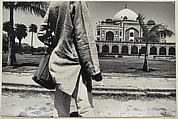Towards an Indian Gay Image, Humayun’s Tomb, New Delhi
Sunil Gupta Canadian/British
Not on view
Born in New Delhi, Sunil Gupta immigrated with his family to Canada in 1969 at the age of fifteen. He returned to India in 1980, having received a student award from Thames Television to photograph rural poverty in Rajasthan. While traveling through New Delhi, Gupta—who is gay—became interested in documenting urban gay life there. However, he learned that although a gay community existed, nothing happened publicly, and men certainly would not want to be photographed. Frustrated, Gupta staged a few photographs of anonymous men purportedly cruising in various locations around Delhi, which resulted in a group of fourteen gelatin-silver prints that, until 2020, were rarely exhibited or published, and were later titled Towards an Indian Gay Image.
This image depicts a man with his back to the camera, holding a cigarette, with his head cropped out of the frame as he gazes toward the Mughal monument, Humayan’s tomb. It was first published in The Guardian in November 1982 to accompany an article by Gupta, "They dare not speak its name in Delhi: Sunil Gupta on the secret suffering of India’s homosexual community." At the time, being gay in India was illegal as decreed by Section 377 of the Indian Penal Code, instituted in 1861 during British colonial rule. As Gupta wrote: "Always there is fear of discovery... an exclusively gay identity does not seem possible." The law was overturned in 2018.
This image cannot be enlarged, viewed at full screen, or downloaded.

